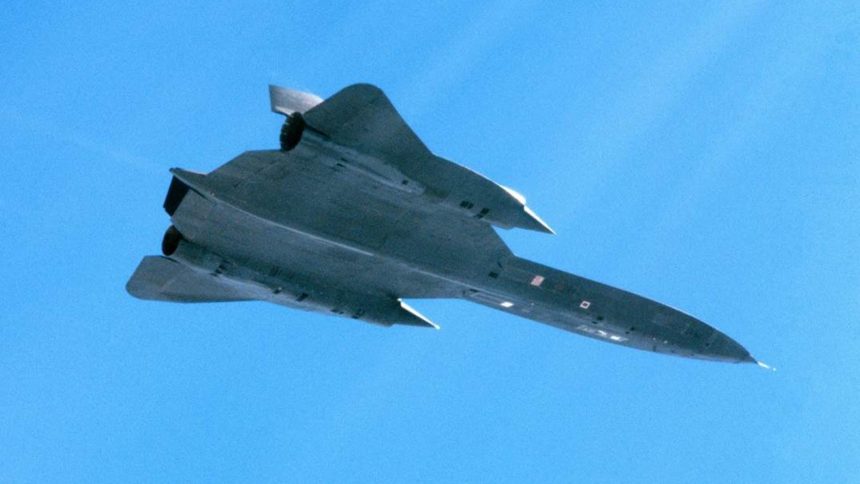An interesting Cold War episode worth 4 medals.
During the 1980s, the U.S. flew regular SR-71 Blackbird aircraft reconnaissance missions in international waters over the Barents Sea and the Baltic Sea, the latter known as “Baltic Express” missions. On June 29, 1987, during one of those missions, a Blackbird launched from RAF Mildenhall, UK, piloted by retired Lt. Cols. Duane Noll and Tom Veltri, experienced a pretty serious inflight emergency.
Flying a northern course, at 75,000 feet and Mach 3.0, its right engine exploded. In order to manage the emergency, the aircrew immediately turned towards Sweden, rapidly descending. At an altitude of 25,000 feet, approaching Gotland Island, the Blackbird violated the Swedish airspace triggering a reaction by the Swedish Air Force.
The Air Defense radar that was tracking the aircraft asked two Saab JA 37 Viggen jets, belonging to the F 13 Norrköping, already in flight for another mission, to intercept the intruder a perform a so-called VID (Visual IDentification).
“We were performing an ordinary peace time operation exercise,” recalled retired Maj. Roger Moller, Swedish air force Viggen pilot. “Our fighter controller then asked me are you able to make an interception and identification of a certain interest. I thought immediately it must be an SR-71, otherwise he would have mentioned it. But at that time I didn’t know it was the Blackbird.”
About 70 kilometers east of Öland’s southern oceans, the two Swedish Viggens intercepted the SR-71.
Moller and his wingman Maj. Krister Sjöberg shadowed the Blackbird for about five minutes at a distance of about 30 meters. From that position they could see that Blackbird was flying on one engine and that it carried the registration 117964.
Meanwhile, a second pair of Viggens had been scrambled by F 10 in Ängelholm (where F 6 was temporarily deployed) to relieve the first pair that would soon run out of fuel. Piloted by Col. Lars-Erik Blad and Lt. Bo Ignell, they got visual with the Blackbird and the other Viggens about 70 kilometers east of Bornholm, in international airspace. The arrival of the second pair of AJ 37s allowed the first one to return home.
“We saw that the plane was flying at low speed and was constantly decelerating. In order to remain unseen, I made a break on their right side and then a 360 degree turn so I got up behind and above the Blackbird to have a good overview of the situation. My wingma remained on their right side,” said Lars-Eric Blad in a Swedish Air Force release.
With a transponder code set to 7700 (the ICAO code for an Emegency), the SR -71 continued to lose height so much so, the Swedish pilots were unsure whether the plane would eventually crash or the pilots would have to eject. However they continued to escort the American spyplane that, at low speed and altitude, was extremely vulnerable.
“We did not know who would find us first. Seeing the Swedish plane escorting us was a pure liberation. I’m absolutely sure that the Swedish presence on meant that other interceptors were at distance and could not therefore come to intercept us, “said Tom Veltri, one of the SR-71 pilots that day.
The Swedish escorted the SR-71 until the they reached the Danish airspace.
“Then we were down to about 12,000 feet, but thankfully, we saw no other planes in the area,” said Lars-Eric Blad.
In spite of the emergency the SR-71 was eventually able to land at Nordholz in the former West Germany.
The four Swedish air force pilots received U.S. Air Medals during a ceremony held in Stockholm on Nov. 28, 2018, recognizing their actions that took place over 31 years ago. Although the episode is described in several books, until last year the details of their mission remained classified.
According to the Air Medal citation, once the Swedish pilots intercepted the SR-71, they assessed the emergency situation and decided to render support to the aircraft by defending it from any potential third-party aircraft that might have tried to threaten it. The pilots then accompanied the aircraft beyond the territorial boundaries and ensured that it was safely recovered.
“I can’t say enough about these gentlemen,” said Veltri, who was at the ceremony. “I am so amazingly grateful for what they did, but also for the opportunity to recognize them in the fashion we are doing. What these guys did is truly monumental.”
Noll, who was not able to be at the ceremony, recorded a message which was played to those in attendance.
“Your obvious skills and judgement were definitely demonstrated on that faithful day many years ago. I want to thank you for your actions on that day,” said Noll. “We will never know what would or could have happened, but because of you, there was no international incident. The U.S. Air Force did not lose an irreplaceable aircraft, and two crew members’ lives were saved. Lt. Col. Veltri and I can’t thank you sufficiently for what you prevented. Thank you for being highly skilled and dedicated patriotic fellow aviators.”
H/T Lars Westholm for helping with this story.










